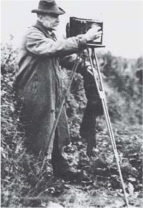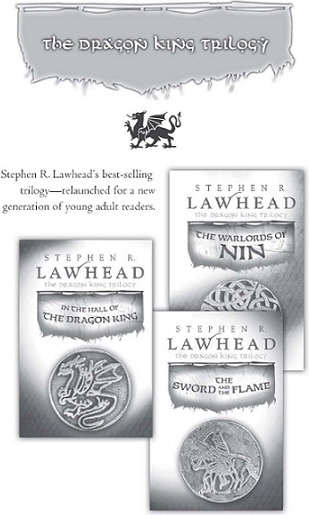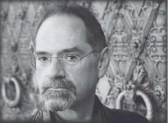The Skin Map (43 page)
Authors: Stephen R. Lawhead

“That won’t be necessary,” said Douglas Flinders-Petrie, pushing through the crowd. “I’ll take responsibility.”
He moved quickly to the smouldering youth, interposing himself between the boy and the crowd. “Listen, you little guttersnipe,” he hissed, bending over him. “Come with me now if you want to stay out of gaol.” Then, taking the boy by the hand, he began leading him away.
“Oi! You there!” called one of the citizens. “You know that boy?”
“Yes,” called Douglas over his shoulder. He kept walking. “It’s all right.”
“Are you his father?” called another onlooker.
“Yes,” he answered, then added under his breath, “I am now.”
T
he author gratefully acknowledges the assistance provided by Wael El-Aidy (Egyptian history, language, and customs), Danuta Kluz (German language), Clare Backhouse (17th-Century customs, manner, and dress), Suzannah Lipscomb (British history), Drake Lawhead (London transport and matters arising), and Ross Lawhead (general editorial). All mistakes and liberties are, of course, my own.
The Ley of the Land
AN ESSAY BY STEPHEN R. LAWHEAD.
I
first visited Stonehenge—one of the Seven Wonders of the Neolithic World—in the summer of l985. Friends had taken us to the site and, as fascinating as the structure was and remains, my attention that day was drawn to the people around us and how they interacted with the monument. In addition to the tourists one would expect, there were also small groups of barefoot bohemians stalking the grassy field surrounding the ancient stone circle. With arms outstretched and faces to the sky, they seemed to drift around in some sort of trance, oblivious to the imposing megaliths. I took them for hippies who didn’t get the memo that the ’60s were over. My friend said, “They’re New Agers, searching for ley lines. See how they waggle their fingers? They’re trying to pick up the energy.”
I dismissed them as eccentrics, of course, and thought no more about it until the repeated experience of seeing similar activity at Avebury, Rollright, and the Callinish Stones began to percolate in my thinking. And then, on a walking trip in Southern Tuscany, my wife and I visited the beautiful abbey at Sant’Antimo. It is a holy site that cannot fail to make an impression, and which has enjoyed several incarnations, most recently a Cistertian monastery.
We have visited the church three times now, and it was on the last visit that I attended an exhibit at the back of the Romanesque building. Researchers have mapped the telluric energy flow of the little valley in which the church nestles, and discovered no fewer than seven branches of deep earth energy, which all meet and terminate at a precise point below the church’s altar. A map tracing the lines of force coursing beneath the floor of the church was displayed, along with a description of the mapping work.
What’s going on?
Alfred Watkins was an early twentieth century enthusiast who, when he wasn’t stirring up enduring archaeological controversies, held elected public office, ran several businesses, and, as a pioneer of British photography, is credited with inventing several early photographic instruments. Watkins spent a lot of time on horseback riding across the English countryside, going from town to town in support of the family milling business. On one of these rambles he noticed how odd it was that many familiar landmarks seemed to be linked one to another in absolutely straight lines stretching for miles across the landscape; churches, holy wells, and stone crosses were connected to stone circles, dolmens, tumulus burial chambers, beacons, man-made mounds, standing stones, Roman roads, notches cut in hillsides, and other features of the ancient British landscape. He began looking for and recording these observed lines on a map, and he dubbed them “ley lines.” In the autumn of 1922 he gave a talk at a local naturalist society meeting and later published a booklet called
Early British Trackways
in which he detailed his observations and asked for others to join him in the search, not only for more lines, but for an explanation.

Alfred Watkins
A few years later Watkins published another book called
The Old Straight Track
—to which my own character, Cosimo Livingstone, refers in this volume—documenting the concept and giving it wider public attention. This was soon followed by a field guide called
The Ley Hunter’s Manual
, and the game was afoot. What are these strange lines? What is their purpose? Why were they made?
Watkins never found out. He spent the last fourteen years of his life amassing evidence to support his theories but died none the wiser. Others joined the search and work continued, and though the ley concept has never been warmly embraced by orthodox archaeologists and anthropologists, the phenomenon has never been explained and thus has never really gone away. Theories abound—all the way from commonsense and practical, to out-and-out loony. At one point someone got the bright idea to measure some of the better-known ley lines and so, employing various means detecting electromagnetic currents, researchers have found that many of them do radiate some degree of energy along these curious lines. Why this should be so and how the ancients sensed the presence of this energy, why they marked it, and how they may have employed it all remains a tantalising mystery.
Do ley lines exist? Are they connected with the telluric energy that is associated with various geodynamic forces of the earth: underground streams, fault lines, movement of the earth’s crust, and even, perhaps, lightning strikes? Or is it all just a bit of hopeful speculation, half-science and New Age nonsense—something to file in the same low drawer as Nessie and Big Foot?
Not being a scientist, it is my particular privilege to roam freely in the world of “what if ” without having to prove anything. There seems enough empirical evidence to warrant at least some open-minded speculation—and, in light of all that Kit and Cosimo have experienced, who can say absolutely that ley travel is not possible?
Stephen Lawhead
Oxford, 2010
C
OMING
S
EPTEMBER
2011
A B
RIGHT
E
MPIRES
N
OVEL
Quest the Second
THE
BONE HOUSE




Stephen R. Lawhead is an internationally acclaimed author of mythic history and imaginative fiction. His novels include the King Raven trilogy, the Song of Albion trilogy, the Dragon King trilogy, and the Pendragon Cycle series. Lawhead makes his home in Oxford, England, with his wife.
visit
StephenLawhead.com
